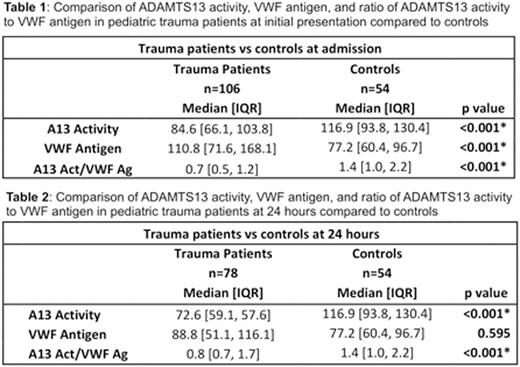Abstract
Background: Acute traumatic coagulopathy occurs in both pediatric and adult trauma patients and is associated with an increased risk of mortality. Trauma patients not only have increased risk for hemorrhagic complications, but also are at increased risk for thrombosis due to multiple factors including local tissue injury, inflammation, and immobility. The complex underlying pathophysiology of coagulation abnormalities associated with traumatic injury have yet to be fully elucidated. Additionally, there are significant differences in the hemostatic system of pediatric patients compared to adults.
Objectives: The purpose of this study was to determine the levels of coagulation parameters including von Willebrand factor (VWF) antigen and ADAMTS13 activity in pediatric trauma patients and evaluate for possible association with injury severity and/or mortality.
Methods: This study utilized plasma specimens collected from pediatric trauma patients that presented to our institution over a 2-year time period. The specimens were collected at initial presentation and 24 hours later. The injury severity was estimated using both the Glasgow Coma Scale (GCS) and Injury Severity Score (ISS). A cohort of control samples was obtained from pediatric patients for elective surgical procedures over the same time period. Plasma VWF antigen was determined by a sandwich ELISA; plasma ADAMTS13 activity was determined by FRETS-VWF73. The results were determined by nonparametric tests for the differences in median values.
Results: A total of 106 trauma patient samples at initial time point, 78 trauma samples at 24 hour time point, and 54 control samples were obtained and utilized for study. There were statistically significant differences (p<0.05) in the plasma levels of VWF antigen, ADAMTS13 activity, and the ratio of ADAMTS13 activity to VWF antigen for the trauma patient samples at initial presentation when compared to controls (Table 1). At 24 hours, there were still statistically significant differences between ADAMTS13 activity and the ratio of ADAMTS13 activity to VWF antigen in trauma patients compared to controls, but there was no significant difference in VWF antigen between the two cohorts (Table 2). There was a significant difference between the decrease in ADAMTS13 activity and injury severity as estimated by ISS ³ 15 or GCS < 8 at both time points; however, ADAMTS13 activity was not statistically different in survivors vs. non-survivors. A higher VWF antigen level at initial presentation was the only factor found to be significantly different in non-survivors.
Conclusions: This study demonstrates significant differences in plasma ADAMTS13 activity and VWF antigen in pediatric trauma patients compared to controls. In patients with more severe injuries as estimated by GCS and ISS, there was also a significant association with decreased levels of ADAMTS13 activity. These finding may underlie part of the prothrombotic propensity in microcirculation that occurs in patients post-trauma. Further investigation is warranted to better understand the mechanisms of acute traumatic coagulopathy and potential prognostic factors, and to determine the most effective interventions for acute traumatic coagulopathy in the pediatric population.
Zheng:Ablynx: Consultancy; Alexion: Research Funding.
Author notes
Asterisk with author names denotes non-ASH members.


This feature is available to Subscribers Only
Sign In or Create an Account Close Modal